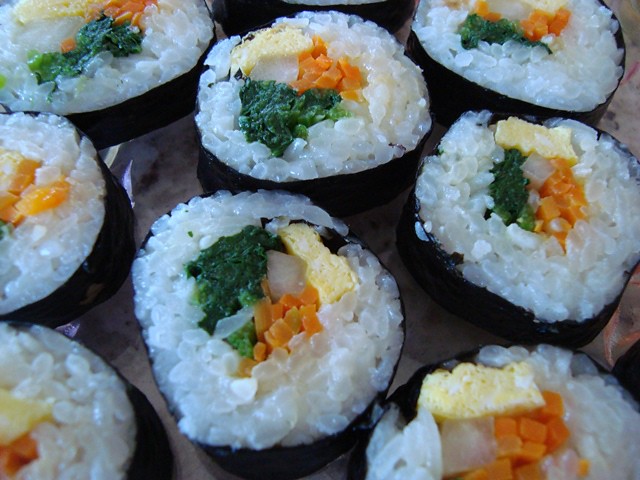Having spent the better part of five years in Korea you can believe I've eaten plenty of strange Korean foods.
Live octopus? Sure. Tube worm? You bet. Pickled jellyfish? Delicious.
These are all fine examples of curious Korean cuisine and worth a try if you find yourself in the Land of Morning Calm. Granted, they may not be as accessible as, say, a hamburger or fried chicken, but they're lots more interesting!
If you're looking for a more adventurous meal let me recommend one of my favorite strange Korean foods.
Pig Guts Soup
Chances are even if you know next to nothing about Korean food you've at least heard of kimchi and Korean barbecue. Both are deserving of their fame and a definite treat for the taste buds.
Korean barbecue is particularly delicious: Imagine meaty cuts of pig that fall somewhere between pork chops and bacon in taste and consistency grilled right at your table. A fabulous foody experience.
But after you've butchered a pig for barbecuing there's still plenty of meat leftover. From the hooves to Wilbur's inner-workings, you've got lots of good eating still to do.
Koreans are big on making the most of every pig they butcher and nowhere is that more evident than in a bowl of pig guts soup.
When you dig into this strange Korean food you'll find discover a bounty of pig intestine, liver, and bits of pork. It is quite literally a bowl of pig guts.
How does it taste? Well, the flavor isn't as strong as you'd probably imagine, although every time I've enjoyed this dish there is the faintest aftertaste of manure.
It isn't overpowering, mind you, but it' unmistakably there. I suppose that shouldn't come as a shock. I mean, you are after all eating a pig's digestive track.
Like a lot of Korean cuisine you can choose to spice up pig guts soup with red pepper paste. A dollop of this ubiquitous condiment gives the dish some kick and helps to mask the aftertaste.
A Piggy's Tale
Traditionally, pig guts soup was most popular amongst peasants, farmers, and laborers. It still has a reputation as "peasant food".
This plebeian history tends to be reflected in the clientele scarfing down pig guts soup today. A typical restaurant serving the stuff will offer a good cross-section of low-income Korean society: poor college students, gritty blue collar types, factory workers, and folks who enjoy life's simpler pleasures.
A bowl of pig guts soup will run you about 6,000 won at most restaurants. You won't need to break the piggy bank to enjoy it. In addition to an affordable price, this strange Korean food does a good job of keeping you full.
I'm not sure if intestines are just very filling, but after a bowl of pig guts soup I'm set for hours.
Pass the Pig Guts Soup
If you're up for this culinary adventure pig guts soup is easy to find throughout Korea. Just look for "naeg jeong mari guk bap" on the menu and prepare for the local's eyes to bug when you place your order.
From my experience I've found that the dingier the restaurant looks the more delectable the dishes tend to be. So find yourself a dive and dig in!
Ingredients
INGREDIENTS:
1 pig stomach
1 -2 pieces of pork rumps
A handful of white pepper, cracked (depending on the spiciness to your liking)
salt to taste
Pig Maw cleaning method: (refer to video -http://bit.ly/fz7ukM )
Turn the pig’s maw inside out (like you do with your shirts) and clean the pig stomach by washing it with salt and tapioca flour (cassava root starch). For better result rub the stomach with banana leaf or assam (tamarind) paste which can easily get rid of the slimy and sticky feeling of the stomach. Repeat this process a few times to get rid of the fats (white stuff) and other impurities on the lining. Rinse with running water. Turn the stomach back and repeat the washing steps on the outside. When to stop cleaning? Test it by smelling it! It sounds a bit gross but it’s an effective way to tell whether the stomach is still smelly.
OPTIONAL INGREDIENTS:
mushroom (soaked)
Gingko
How to make it
1. Pour boiling water over the cleaned pig stomach (inner lining) and use knife to get rid of yellow inner membrane around the stomach and trim off any fats attached on the lining.
2. Turn the inner lining stomach back and stuff the whole pork rumps into the pig stomach thru the small opening, put half the quantity of the cracked peppers in too.
3. Simmer the stomach using slow cooker (crock pot) or over stove using low heat, it takes at least one and a half hours.
4. You can add in the optional ingredients mushroom, gingko at the last 30 minutes.
5. To test if the pig’s stomach is ready, use a fork to poke in the center, if fork go in easily, then it is ready else continue to simmer.
6. Add in seasoning and final taste test.
7. When ready, remove the pork rumps and slice the pig’s maw into stripes and serve with soup.

